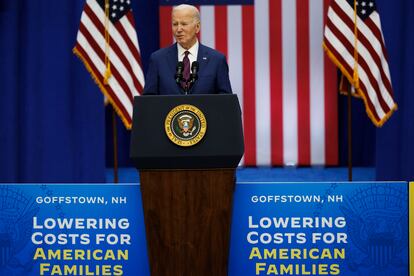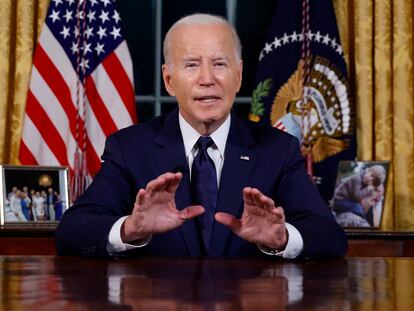Biden’s budget proposal for a second term offers tax breaks for families and lower health care costs
The proposal for fiscal 2025 is an election year blueprint about what the future could hold if President Joe Biden and enough of his fellow Democrats win in November

President Joe Biden on Monday released a budget proposal aimed at getting voters’ attention: It would offer tax breaks for families, lower health care costs, smaller deficits and higher taxes on the wealthy and corporations.
Unlikely to pass the House and the Senate to become law, the proposal for fiscal 2025 is an election year blueprint about what the future could hold if Biden and enough of his fellow Democrats win in November. The president and his aides previewed parts of his budget going into last week’s State of the Union address, and they provided the fine print on Monday.
If the Biden budget became law, deficits could be pruned $3 trillion over a decade. It would raise tax revenues by a total of $4.9 trillion over that period and use roughly $1.9 trillion to fund various programs, with the rest going to deficit reduction.
Biden aides said their budget was realistic and detailed while rival measures from Republicans were not financially viable.
“Congressional Republicans don’t tell you what they cut, who they harm,” White House budget director Shalanda Young said. “The president is transparent, details every way he shows he values the America people.”
House Speaker Mike Johnson, R-Louisiana, issued a joint statement with other GOP leaders calling the Biden proposal a “glaring reminder of this Administration’s insatiable appetite for reckless spending.”
“Biden’s budget doesn’t just miss the mark — it is a roadmap to accelerate America’s decline,” the House Republican leaders said.
Under the proposal, the government would spend $7.3 trillion next fiscal year and borrow $1.8 trillion to cover the shortfall from tax receipts. Biden’s 188-page plan covers a decade’s worth of spending, taxes and debt.
Parents could get an increased child tax credit in 2025, as payments would return briefly to the 2021 level funded by Biden’s coronavirus pandemic relief package. Homebuyers could get a tax credit worth up to $10,000 and $10 billion in down payment aid for first-generation buyers. Corporate taxes would jump upward, while billionaires would be charged a minimum tax of 25%.
Biden said in his State of the Union that Medicare should have the ability to negotiate prices on 500 prescription drugs, which could save $200 billion over 10 years. Aides said his budget does not specify how many drug prices would be subject to negotiations.
The president is traveling Monday to Manchester, New Hampshire, where he’ll call on Congress to apply his $2,000 cap on drug costs and $35 insulin to everyone, not just people who have Medicare. He’ll also seek to make permanent some protections in the Affordable Care Act that are set to expire next year.
Biden’s plan would permanently keep Medicare solvent, according to aides, but as noted by Maya MacGuineas, president of the fiscal group Committee for a Responsible Federal Budget, it does not appear to fix Social Security, which projections say will be unable to pay full benefits starting in 2033.
The proposal would provide about $900 billion for defense in fiscal 2025, about $16 billion more than the baseline.
The Biden administration is still seeking money to help Ukraine defend itself against Russia and aid for Israel. His budget plan reiterates the supplemental funding request made last October for Ukraine, Israel and humanitarian relief for Palestinians
It’s also requesting funding to expand personnel and resources at the U.S. southern border. Still, military spending over 10 years would decline $146 billion to $9.57 trillion.
One key theme in the budget plan is an effort to help families afford their basic needs, as the impact of inflation hitting a four-decade high in 2022 continues to leave many voters feeling as though they’re worse off under Biden.
The budget proposal includes $258 billion to help build or preserve 2 million homes, helping to address a national shortage that has kept housing prices high. Parents making under $200,000 annually would have access to child care, with most eligible families paying no more than $10 a day.
It would eliminate origination fees on government student loans, possibly saving borrowers $1,000 over the life of the debt. It also includes $12 billion to help universities develop strategies for reducing their costs.
All of this is a chance for Biden to try to define the race on his preferred terms, just as the all-but-certain Republican nominee, Donald Trump, wants to rally voters around his agenda.
“A fair tax code is how we invest in things that make this country great: health care, education, defense and so much more,” Biden said at Thursday’s State of the Union address, adding that his predecessor enacted a $2 trillion tax cut in 2017 that disproportionately benefited the top 1% of earners.
Trump, for his part, would like to increase tariffs and pump out gushers of oil. He called for a “second phase” of tax cuts as parts of his 2017 overhaul of the income tax code would expire after 2025. The Republican has also said he would slash government regulations. He has also pledged to pay down the national debt, though it’s unclear how without him detailing severe spending cuts.
In a Monday interview with CNBC, Trump indicated that he would be willing to reduce spending for Social Security, Medicare and Medicaid, though he did not offer a full policy.
“There is a lot you can do in terms of entitlements, in terms of cutting,” Trump said.
House Republicans on Thursday voted their own budget resolution for the next fiscal year out of committee, saying it would trim deficits by $14 trillion over 10 years. But their measure would depend on rosy economic forecasts and sharp spending cuts, reducing $8.7 trillion in Medicare and Medicaid expenditures. Biden has pledged to stop any cuts to Medicare.
Meanwhile, Congress is still working on a budget for the current fiscal year. On Saturday, Biden signed into law a $460 billion package to avoid a shutdown of several federal agencies, but lawmakers are only about halfway through addressing spending for this fiscal year.
Sign up for our weekly newsletter to get more English-language news coverage from EL PAÍS USA Edition
Tu suscripción se está usando en otro dispositivo
¿Quieres añadir otro usuario a tu suscripción?
Si continúas leyendo en este dispositivo, no se podrá leer en el otro.
FlechaTu suscripción se está usando en otro dispositivo y solo puedes acceder a EL PAÍS desde un dispositivo a la vez.
Si quieres compartir tu cuenta, cambia tu suscripción a la modalidad Premium, así podrás añadir otro usuario. Cada uno accederá con su propia cuenta de email, lo que os permitirá personalizar vuestra experiencia en EL PAÍS.
¿Tienes una suscripción de empresa? Accede aquí para contratar más cuentas.
En el caso de no saber quién está usando tu cuenta, te recomendamos cambiar tu contraseña aquí.
Si decides continuar compartiendo tu cuenta, este mensaje se mostrará en tu dispositivo y en el de la otra persona que está usando tu cuenta de forma indefinida, afectando a tu experiencia de lectura. Puedes consultar aquí los términos y condiciones de la suscripción digital.
More information
Archived In
Últimas noticias
Most viewed
- Sinaloa Cartel war is taking its toll on Los Chapitos
- Oona Chaplin: ‘I told James Cameron that I was living in a treehouse and starting a permaculture project with a friend’
- Reinhard Genzel, Nobel laureate in physics: ‘One-minute videos will never give you the truth’
- Why the price of coffee has skyrocketed: from Brazilian plantations to specialty coffee houses
- Silver prices are going crazy: This is what’s fueling the rally










































